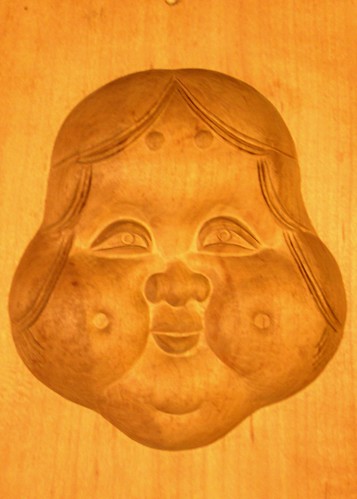

Day forty-eight:
Higashi II
Because "dry sweets", or higashi, are so strongly associated with the tea ceremony, Kyoto has traditionally been a center for higashi production. Typically made of hand-powdered wasambon sugar (perhaps with some starch for added volume or moisture control) higashi are tinted and shaped to evoke a particular season or event. They are commonly formed by pressing the sugar mixture into a carved wooden mold known as a kashigata. Antique kashigata show that higashi were once quite large, but today's higashi is typically a bite-sized serving weighing around 2 grams.
For 200 years, Kamesuehiro has specialized in high quality higashi; the shop even supplies the Kyoto Imperial Palace. In the old days, new kashigata were commissioned for each occasion and the used ones were simply thrown away. A few generations back it occurred to one of Kamesuehiro's proprietors that throwing such skillful carvings away was a waste, so he began to mount them around the shop's large wooden sign. The sign is now framed by dozens of antique kashigata, weathered and stained by the Kyoto air.
For 200 years, Kamesuehiro has specialized in high quality higashi; the shop even supplies the Kyoto Imperial Palace. In the old days, new kashigata were commissioned for each occasion and the used ones were simply thrown away. A few generations back it occurred to one of Kamesuehiro's proprietors that throwing such skillful carvings away was a waste, so he began to mount them around the shop's large wooden sign. The sign is now framed by dozens of antique kashigata, weathered and stained by the Kyoto air.
Although the majority of old molds are either too odd or too large to be of much use, Kamesuehiro still uses a few old kashigata for special ocassions. At around 9 inches in length, the jovial Okame face above is much larger that today's higashi, but it is still used for once-in-a-lifetime events such as an 88th birthday celebration (consequently the mold is in almost pristine condition). Because a sweet of this size would be very expensive and delicate if made of wasambon alone, the sugar is packed around a bean paste core. The eyes are made of wasambon mixed with dye and carefully pressed into the mold, while the hair and lips are painted onto the molded sweet with shokubeni, natural food coloring.

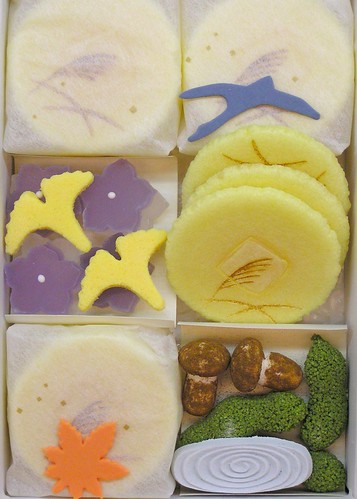
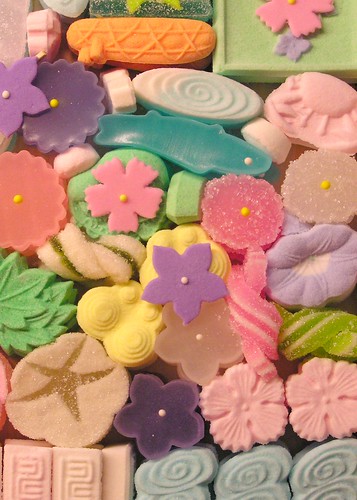
Many shops sell assortments of artistically arranged higashi in small boxes. Elaborately wrapped by the shop, such boxes make elegant gifts. The late summer assortments pictured above are from Kamesuehiro, Tsuruya Yoshinobu, and Kagizen Yoshifusa.
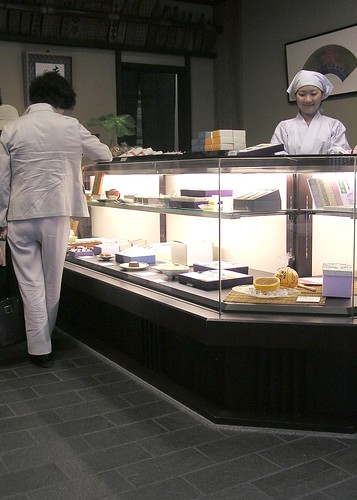
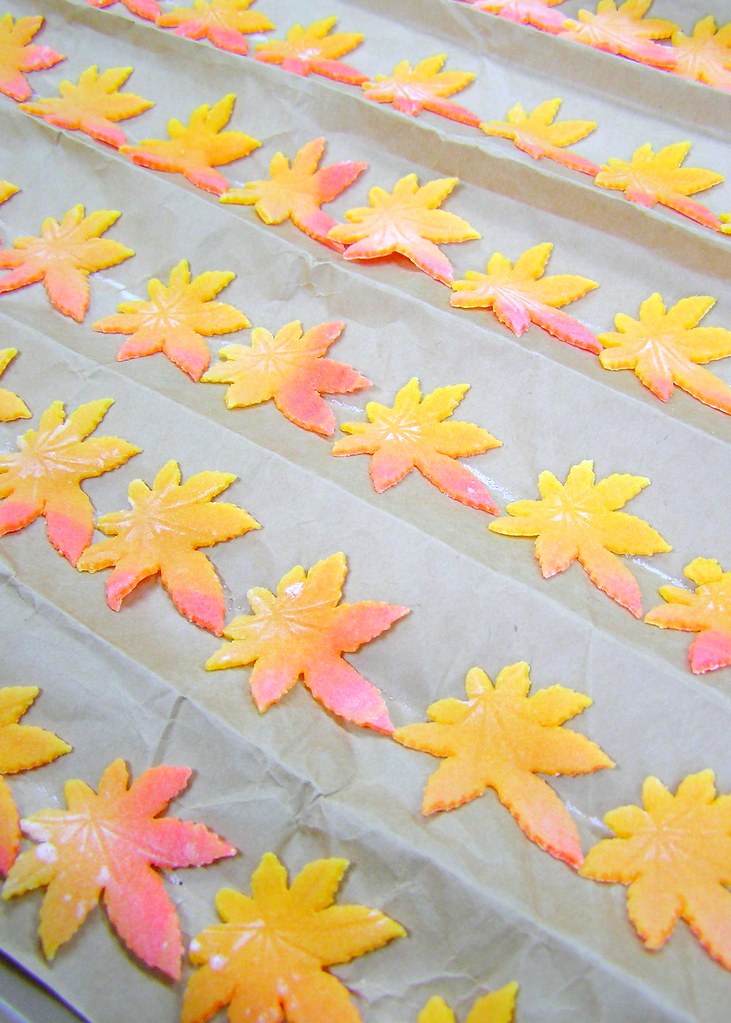
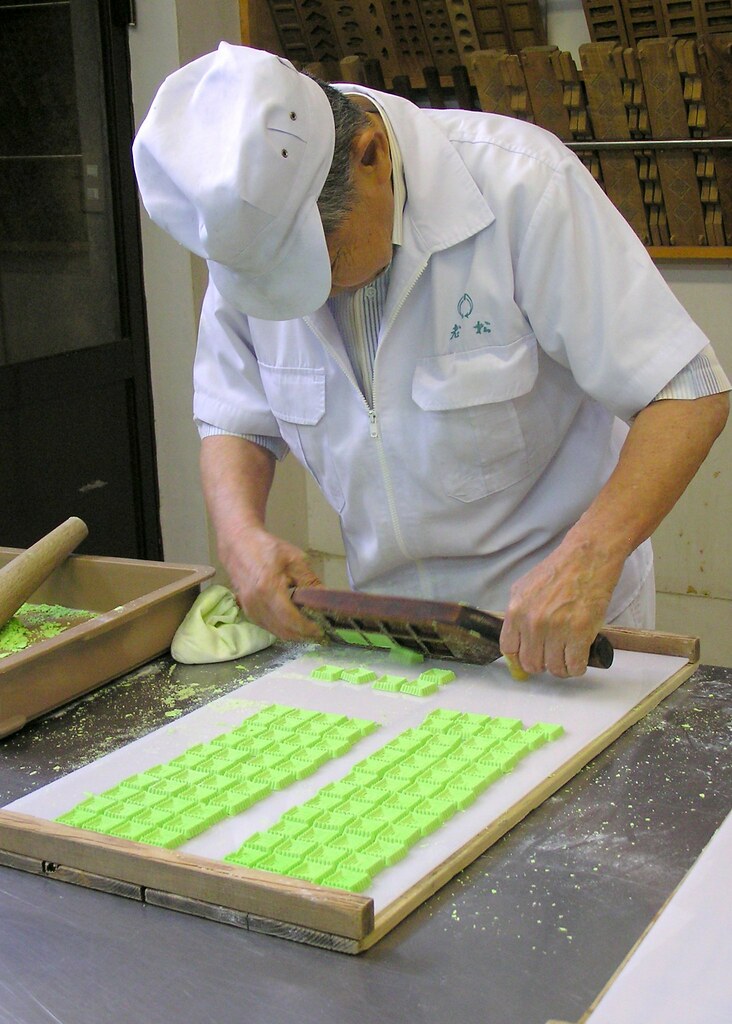
At Oimatsu, my friend Oya gave such a persuasive description of my project that we were invited back to the kitchens to look around. While the showroom (above, left) is decorated with a frieze of impressive but obsolete kashigata, the kitchen walls are covered in racks of those kashigata still in regular rotation.
We were just in time to see one being used, an Edo-period mold depicting markers from kō awase, an archaic incense-identification game (right). The Oimatsu employee was packing the green-tinted wasambon into the molds with such care that it took him about 10 minutes per batch, and with such force that the periodic "CRACK! CRACK!" as he whacked the mold to free the sweets made me jump every time. He also slipped us a few of the broken ones, which were delicious and incredibly delicate.
On another table, racks of higashi made with a maple-leaf cutter were curing on folded wax paper (center) to give them a life-like curl.



Wakasa-ya is another shop that deals almost exclusively in higashi. It was founded 85 years ago and is now run by the original owner's 80-year-old son; it continues to be the official supplier for the Myōho-in Temple. The shop offers a rotating lineup of sweet, somewhat retro designs, such as the one above (center) showing two adorable bunnies doing what bunnies do...pounding mochi inside a full moon. Individual higashi are ¥40 and small assortments start at ¥220.
Some of Wakasa-ya's molds (right) are carved by Jiro Noguchi, Kyoto's only active kashigata carver, and someone I've been trying to ingratiate myself with for about 8 years. When I told Wakasa-ya's proprietor that Noguchi-san has never responded to any of my letters, he wasn't at all surprised: "Maybe...he is not such an easy person."


2 comments:
wow, cool article! I have found that dealing with some of the older Japanese artisans is quite challenging..I won't presume to know of the social aspects of why they are slow to respond but it definately is a language thing to begin with.
Do you know of anyone who might be able to give me a lead on where to buy wooden higashi molds? I am interested in making them here in the States to use for tea ceremony.
david
There is an online store that offers higashi (dry sweets). Checkout www.TeaDogu.com. They can also steer youto wooden higashi molds.
Post a Comment